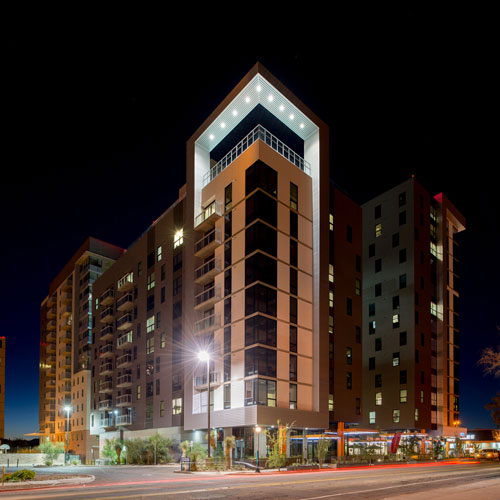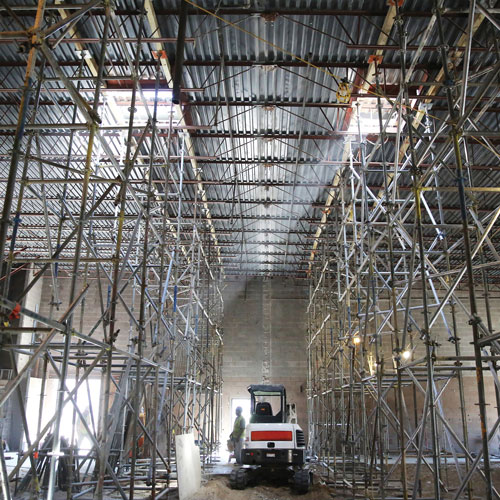With its miles-long beaches, delicious seafood, small-town feel, and notable peace and quiet in the cooler off-season months between Labor Day and Memorial Day, Cape Cod, Massachusetts, has become a popular destination for people looking to retire. This has presented an added challenge, though, for the peninsula’s leading health-care provider, Cape Cod Healthcare Inc., which offers services for area residents and visitors alike.

“Aging populations generally require more medical services,” says Edward Browne, the company’s director of facilities, real estate, and construction, noting that 27 percent of the cape’s population is 65 or older. “Even transportation is a big issue. Patients not only have to get here; they have to get back to their doctor’s offices or rehab. Ease of access to health care is important.”
In 2011, Cape Cod Healthcare recognized it simply couldn’t keep up with area demand. Its two hospitals—Cape Cod Hospital in Hyannis and Falmouth Hospital in Falmouth—had emergency centers that were built to handle far fewer patients than they were receiving. Cape Cod Hospital, for example, was built for 60,000 visits a year but was taking in more than 90,000. As a result, many patients were assigned to beds in nonprivate spaces such as hallways. “Privacy in both locations was not what it should be for patients, families, and physicians, and that needed to be addressed,” Browne says.

Expanding proved difficult, however, given that Cape Cod is essentially a 65-mile-long sand dune—and a historic one at that. “There’s an ecological balance you have to achieve, and you also have to consider the ambience of what folks want to see here on the cape,” says Browne, who had to get the renovations to both his company’s emergency centers approved by the Cape Cod Commission, which all towns on the peninsula have agreed to let govern development. “We had to demonstrate to them that we were not affecting any wetlands or historical features of the area, that we’d take traffic into consideration, and that we weren’t increasing light pollution with our exterior lighting.”
Accounting for Tourism
Designing a health-care facility in a vacation town involves some complicated math. In the summer, Cape Cod’s population swells from roughly 200,000 to 500,000, and in total, the region attracts five million summer visitors annually. This makes it hard to calculate and plan year-round usage. “Our facilities have to be unique, as does our construction.” says Edward Browne, director of facilities, real estate, and construction for Cape Cod Healthcare.
When renovating the emergency centers at Cape Cod and Falmouth Hospitals, for example, Browne ensured that construction zones were set up and that all changes in road access and parking were complete well before May 1. His team didn’t allow additional disruptions until after September 30. “We could do work in cordoned-off construction zones, but we couldn’t create new zones or pave roadways because access and parking is so critical to handling the influx of patients we see in the summer,” Browne says.
Ultimately, Cape Cod Healthcare managed to conceive balanced designs that the commission found favorable, and it set to work expanding both of its facilities, adding 74 private emergency-treatment beds to the 41,000-square-foot Cape Cod Hospital and 41 beds to the 21,600-square-foot Falmouth Hospital. The treatment spaces at the facilities are now state of the art, too, with elements meant to cater to the skewed population of the cape. “A lot of changes stemmed from the type of patient we serve, which in our case is geriatric,” Browne says.
Lighting at both emergency centers, for example, was designed to keep patients oriented and ensure that they have an overall sense of well-being, and both now have clerestories that allow natural light to flow into treatment spaces. At the same time, though, Browne and his team had to keep light levels consistent because geriatric patients have difficulty distinguishing glare. “We used indirect light fixtures, ensured flooring materials weren’t super reflective, and gave patients control of their lighting,” Browne says.
Sound was another issue. “Even though we’ve made spaces larger, we’ve paid a lot of attention to acoustics,” Browne says. “Patients who come into an emergency center already aren’t feeling well, and we don’t want to compound that by barraging them with noise, whether it’s the conversations out in the nurse’s station or the beeps and whistles of medical alarms. You can’t eliminate them, but you can certainly mitigate them.”
Finally, Browne and his team used colors carefully, avoiding vibrant hues in favor of muted tones in the same family. “You can’t have huge contrast in colors because it can create a perception issue,” Browne says. “For instance, if you use a floor-tile pattern with dark next to light, some elderly patients might think there’s a hole, and sometimes they’ll stumble.”
Cape Cod Healthcare is close to completing its renovations, and more impressively, its hospitals have remained operational throughout the process thanks to a phased construction approach. “When you walk into an emergency center, you first enter a waiting area where a nurse greets and triages you, and that’s what we built first in Hyannis,” Browne says. “Right behind it was a false wall where we built the new space while the old space was down around a corner.”
At the same time that Browne has been renovating the two emergency centers, he’s also built two new urgent-care centers of roughly 3,500 square feet each, one in Sandwich and one in Harwich. Designed to address less-serious medical problems, from cuts to sprains, these sites see more than 100 patients a day, minimizing patient volumes at the emergency centers and ensuring that everyone who lives on or visits the cape has easy access to medical care. “Nowhere on this peninsula do you have to drive more than 30 minutes to get urgent or emergency care,” Browne says.
The changes will make all the difference, and according to Browne, they were largely possible because of the support of the community across the peninsula. “They knew,” he says, “that improving access to medical care was very important.”




